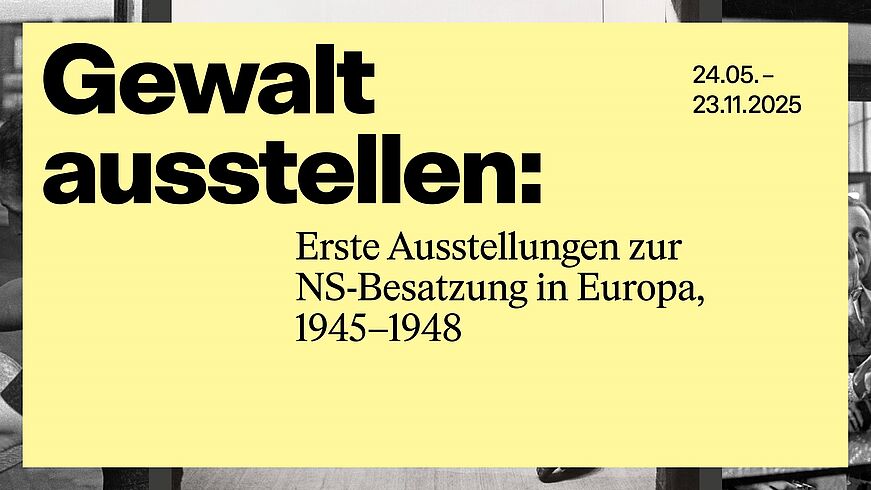Invitation to the Press Conference Wednesday, 21 May 2025, 11 am
“On Displaying Violence: First Exhibitions on the Nazi Occupation in Europe, 1945–1948”
Download
Dear Ladies and Gentlemen of the Press,
We are pleased to invite you to the Press Conference on
Wednesday, 21 May 2025 at 11 am in the
Pei Building (ground floor, auditorium) of the Deutsches Historisches Museum
Speakers:
Raphael Gross, President of the Stiftung Deutsches Historisches Museum
Agata Pietrasik, Curator of the exhibition
Annette Wolf, Staff member of the Documentation Centre “German Occupation of Europe in the Second World War” (ZWBE)
It is possible to view the exhibition starting at 10 am in the Pei Building (ground floor). The event takes place in German and English. The curator will introduce the exhibition project in English. Consecutive interpretation is available for the Q&A.
At the height of its power, National Socialist Germany occupied almost all of Europe. Some 230 million people in what are now 30 countries lived under German occupation. How did the postwar societies process their experiences of violence and destruction resulting from the Second World War and the concurrent Nazi occupation? A previously overlooked but historically influential form of coming to terms with this desolation are the exhibitions that were organised throughout Europe immediately after the war. In times of social hardship, political instability, enduring violence, and uncertain future, they aimed to document and visualise the consequences of the Holocaust and the Nazi crimes. With “On Displaying Violence: First Exhibitions on the Nazi Occupation in Europe, 1945–1948”, the Deutsches Historisches Museum traces for the first time the history of this pan-European phenomenon, using the examples of early exhibitions in London, Paris, Warsaw, Liberec, and Bergen-Belsen. The DHM exhibition is presented in cooperation with the Documentation Centre “German Occupation of Europe in the Second World War” (ZWBE). It is the view of the project that a joint European remembrance, and thus a joint European future, depends to a great degree on the shared knowledge of the history of the German occupation.
The DHM exhibition explores various forms and presentations with which the organisers of the early exhibitions – most of them victims of Nazi persecution and Holocaust survivors – took up the themes of violence, resistance, perpetration and the loss of cultural heritage. The different ideas about the future that were reflected in the early exhibitions are explored. The exhibition deals with the different visual languages of the time and compares the sources of the displays within their respective local and national context. It also examines the motivation and specific perspectives of the participants at the time, as well as the impact of these exhibitions, some of which toured extensively across Europe. Original objects, photographs, films, documents, artworks, and multimedia presentations help visitors to understand the challenges and background of this “first look back”.
Please note the following guidelines and the registration form:
- The press conference on 21 May 2025 takes place only within the time slot of 10 am (beginning of accreditation and exhibition preview) to 2 pm.
- Due to the limited seating available in the auditorium (ground floor Pei Building) we request you to register for the press conference. Non-accredited persons can only be permitted to attend if capacity is available.
- Individual interviews are possible after prior application. Please address requests for interviews and shootings in advance to presse@dhm.de.
Please send personal accreditation requests by 5 pm on 20 May 2025 to: https://www.dhm.de/en/accreditation-for-the-press-conference-on-displaying-violence/
Start of the accompanying European event series on 13 May in London and streaming online
To accompany the upcoming exhibition, the DHM extends an invitation to attend the European event series “Facing Nazi Crimes: European Perspectives after 1945”, which takes place from May to October 2025. Developed jointly by the DHM and the Documentation Centre “German Occupation of Europe in the Second World War” (ZWBE), the series is devoted to the social and historical circumstances surrounding the first post-war exhibitions held between 1945 and 1948 in Paris, Warsaw, London, Liberec and Bergen-Belsen. The series will be held at these locations and will conclude in Berlin. The admission-free event series will be streamed online and subsequently accessible on the DHM website.
The first event takes place on Tuesday, 13 May 2025, in cooperation with the German Historical Institute London and the Institute of Historical Research, University of London. The exhibition “The Horror Camps”, which opened in May 1945 in the reading room of the Daily Express in London, showed enlarged photographs from liberated Nazi camps. Questions about the relationship between image and evidence and the public use of degrading images are still profoundly relevant today. The photographer and author Janina Struk, the historian Paul Betts and the curator James Bulgin will discuss these questions in reference to changing historical conditions and curatorial practices.
Registration and streaming links under dhm.de/programme
Further information on the Documentation Centre “German Occupation of Europe in the Second World War” (ZWBE): dhm.de/zwbe
Photos and extensive press information about the exhibition: DHM-Press Room
Update: Number of countries under German occupation

“On Displaying Violence: First Exhibitions on the Nazi Occupation in Europe, 1945–1948”
© Grafik: VISUAL SPACE AGENCY & STUDIO BENS